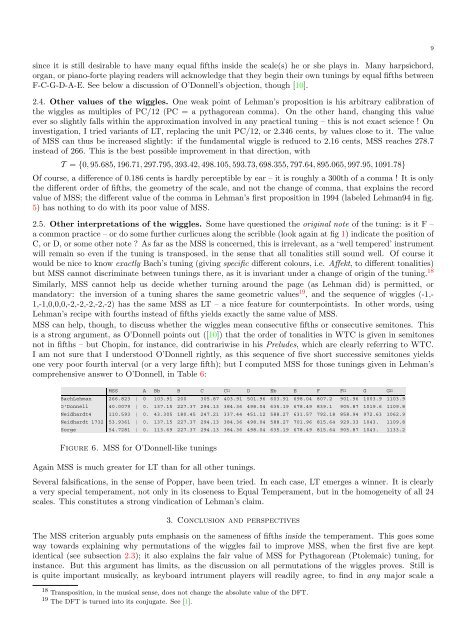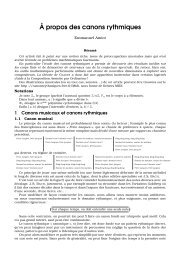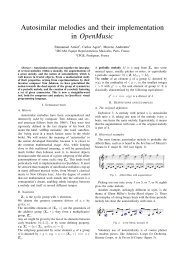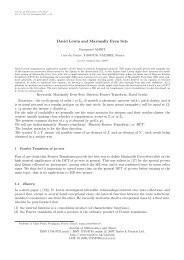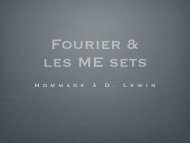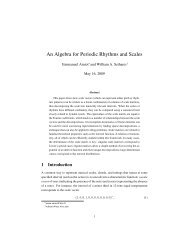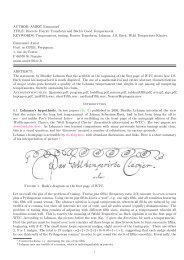Emmanuel Amiot Modèles algébriques et algorithmes pour la ...
Emmanuel Amiot Modèles algébriques et algorithmes pour la ...
Emmanuel Amiot Modèles algébriques et algorithmes pour la ...
You also want an ePaper? Increase the reach of your titles
YUMPU automatically turns print PDFs into web optimized ePapers that Google loves.
since it is still desirable to have many equal fifths inside the scale(s) he or she p<strong>la</strong>ys in. Many harpsichord,<br />
organ, or piano-forte p<strong>la</strong>ying readers will acknowledge that they begin their own tunings by equal fifths b<strong>et</strong>ween<br />
F-C-G-D-A-E. See below a discussion of O’Donnell’s objection, though [10].<br />
2.4. Other values of the wiggles. One weak point of Lehman’s proposition is his arbitrary calibration of<br />
the wiggles as multiples of PC/12 (PC = a pythagorean comma). On the other hand, changing this value<br />
ever so slightly falls within the approximation involved in any practical tuning – this is not exact science ! On<br />
investigation, I tried variants of LT, rep<strong>la</strong>cing the unit PC/12, or 2.346 cents, by values close to it. The value<br />
of MSS can thus be increased slightly: if the fundamental wiggle is reduced to 2.16 cents, MSS reaches 278.7<br />
instead of 266. This is the best possible improvement in that direction, with<br />
T = {0, 95.685, 196.71, 297.795, 393.42, 498.105, 593.73, 698.355, 797.64, 895.065, 997.95, 1091.78}<br />
Of course, a difference of 0.186 cents is hardly perceptible by ear – it is roughly a 300th of a comma ! It is only<br />
the different order of fifths, the geom<strong>et</strong>ry of the scale, and not the change of comma, that exp<strong>la</strong>ins the record<br />
value of MSS; the different value of the comma in Lehman’s first proposition in 1994 (<strong>la</strong>beled Lehman94 in fig.<br />
5) has nothing to do with its poor value of MSS.<br />
2.5. Other interpr<strong>et</strong>ations of the wiggles. Some have questioned the original note of the tuning: is it F –<br />
a common practice – or do some further curlicues along the scribble (look again at fig 1) indicate the position of<br />
C, or D, or some other note ? As far as the MSS is concerned, this is irrelevant, as a ‘well tempered’ instrument<br />
will remain so even if the tuning is transposed, in the sense that all tonalities still sound well. Of course it<br />
would be nice to know exactly Bach’s tuning (giving specific different colours, i.e. Affekt, to different tonalities)<br />
but MSS cannot discriminate b<strong>et</strong>ween tunings there, as it is invariant under a change of origin of the tuning. 18<br />
Simi<strong>la</strong>rly, MSS cannot help us decide wh<strong>et</strong>her turning around the page (as Lehman did) is permitted, or<br />
mandatory: the inversion of a tuning shares the same geom<strong>et</strong>ric values 19 , and the sequence of wiggles (-1,-<br />
1,-1,0,0,0,-2,-2,-2,-2,-2) has the same MSS as LT – a nice feature for counterpointists. In other words, using<br />
Lehman’s recipe with fourths instead of fifths yields exactly the same value of MSS.<br />
MSS can help, though, to discuss wh<strong>et</strong>her the wiggles mean consecutive fifths or consecutive semitones. This<br />
is a strong argument, as O’Donnell points out ([10]) that the order of tonalities in WTC is given in semitones<br />
not in fifths – but Chopin, for instance, did contrariwise in his Preludes, which are clearly referring to WTC.<br />
I am not sure that I understood O’Donnell rightly, as this sequence of five short successive semitones yields<br />
one very poor fourth interval (or a very <strong>la</strong>rge fifth); but I computed MSS for those tunings given in Lehman’s<br />
comprehensive answer to O’Donnell, in Table 6:<br />
MSS A Bb B C C D Eb E F F G G<br />
BachLehman 266.823 0 103.91 200 305.87 403.91 501.96 603.91 698.04 807.2 901.96 1003.9 1103.9<br />
O'Donnell 40.0079 0. 137.15 227.37 294.13 384.36 498.04 635.19 678.49 839.1 905.87 1019.6 1109.8<br />
Neidhardt4 110.593 0. 43.305 180.45 247.21 337.44 451.12 588.27 631.57 792.18 858.94 972.63 1062.9<br />
Neidhardt 1732 53.9361 0. 137.15 227.37 294.13 384.36 498.04 588.27 701.96 815.64 929.33 1043. 1109.8<br />
Sorge 54.7281 0. 113.69 227.37 294.13 384.36 498.04 635.19 678.49 815.64 905.87 1043. 1133.2<br />
Figure 6. MSS for O’Donnell-like tunings<br />
Again MSS is much greater for LT than for all other tunings.<br />
Several falsifications, in the sense of Popper, have been tried. In each case, LT emerges a winner. It is clearly<br />
a very special temperament, not only in its closeness to Equal Temperament, but in the homogeneity of all 24<br />
scales. This constitutes a strong vindication of Lehman’s c<strong>la</strong>im.<br />
3. Conclusion and perspectives<br />
The MSS criterion arguably puts emphasis on the sameness of fifths inside the temperament. This goes some<br />
way towards exp<strong>la</strong>ining why permutations of the wiggles fail to improve MSS, when the first five are kept<br />
identical (see subsection 2.3); it also exp<strong>la</strong>ins the fair value of MSS for Pythagorean (Ptolemaic) tuning, for<br />
instance. But this argument has limits, as the discussion on all permutations of the wiggles proves. Still is<br />
is quite important musically, as keyboard intrument p<strong>la</strong>yers will readily agree, to find in any major scale a<br />
18 Transposition, in the musical sense, does not change the absolute value of the DFT.<br />
19 The DFT is turned into its conjugate. See [1].<br />
9


